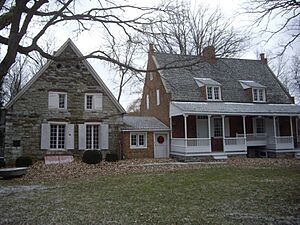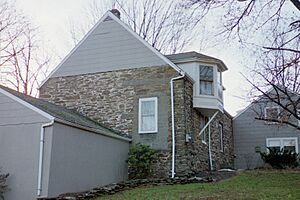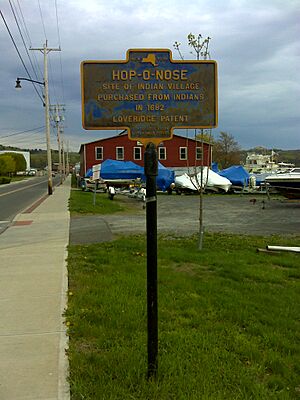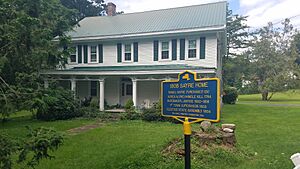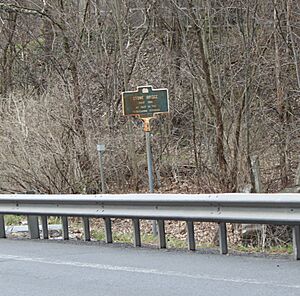List of New York State Historic Markers in Greene County, New York facts for kids
Greene County, New York, is a place rich in history, and you can discover many interesting stories by looking for its historic markers! These special signs are placed by the state to remember important people, places, and events from the past. They help us learn about how communities grew, what life was like long ago, and the brave pioneers who settled here. Let's explore some of these fascinating markers and the history they share.
Contents
Early Settlements and Homes
Many of Greene County's historic markers tell us about the very first homes and villages. These early settlements were often built near rivers or important trails.
First Houses and Villages
- Jan Van Loon House: In Athens, you can find a marker for the Jan Van Loon House, built way back in 1706! Jan Van Loon was a key person in the area, and the village of Athens was first called Loonenburgh after his family.
- Albertus Van Loon House: Another old home in Athens is the Albertus Van Loon House, built in 1724. It's amazing to think this house has been a home for almost 300 years!
- Northup House: Also in Athens, the Northup House was built in 1803. It was the home of Isaac Northup, who helped start the village of Athens, which became an official village in 1805.
- Woodstock: The first settlement in the Town of Cairo was called Woodstock, started in 1791 by James Barker and his tenants. A marker on NYS 32 reminds us of this early community.
- First Log House in Leeds: In Leeds, a marker shows where the very first log house in that village stood. It was built in 1675, just 100 feet south of the road to a river crossing!
- Old Katskill: Near Leeds, a marker points to where the Reformed Dutch Church of Katskill Kockshackie stood, built in 1733. Another marker nearby tells us about a house built in 1729 by Garret Van Bergen, and a barn from 1680 by Marte Gerretse Van Bergen. This area was once an Indian village site.
- Bronck House: One of the oldest houses in Greene County is the Bronck House, built in 1663 by Pieter Bronck near Coxsackie. It's been used as a home for a very long time!
- First House on the Hill: In Coxsackie, a marker tells us about the "First House on the Hill," built around 1800 by Dr. John Ely.
- Log Cabin of Edward Lake: Near East Durham, a marker shows where Edward Lake, an early pioneer, built his log cabin in 1781 on a large 600-acre piece of land.
- Log Cabin of Eleazer Knowles: Another pioneer, Eleazer Knowles, settled in Greenville in 1781 and built his log cabin on a 600-acre lot. A marker on NYS 32 marks this spot.
- First Log House in Hensonville: In Hensonville, the first log house was built in 1818 by John Henson, who founded the village.
- George Stimson's Log Cabin: The very first settler of the Town of Windham, George Stimson, built his log cabin against a rock in 1785. You can find a marker for this on NYS 23 in Windham.
Important Historical Buildings
- First Congregational Church: The First Congregational Church of Ashland was built in 1799 in what was then called Old Windham.
- Trinity Episcopal Church: The Trinity Episcopal Church in East Ashland was officially started on May 20, 1799. It was the earliest Episcopal group in the old Town of Windham.
- Black Horse Inn: The Black Horse Inn, built in 1791 by Isaac Hallenbeck, was an important stop for travelers. A marker for it is on US 9W near Athens.
- Johannes Schuneman Home: The home of Rev. Johannes Schuneman, known as the "Dutch Dominie Of The Catskills," was built in 1792 in Jefferson Heights.
- Pieter Souser's Inn: In Jefferson Heights, Pieter Souser's Inn was a place where important political meetings were held before 1797. There was even a racetrack for pioneers nearby!
- Stone House: A stone house built in 1762 by Lieut. Col. Cornelius Dubois in Catskill was where people celebrated the surrender of Cornwallis during the Revolution.
- Old Inn of Martin G. Schuneman: In Leeds, a marker shows the site of an old inn built in 1796 by Martin G. Schuneman.
- Reformed Church in Prattsville: The first Reformed Church in the mountain towns of Greene County was organized in 1798 and built in 1804 in Prattsville.
Important Industries and Inventions
Greene County also played a role in early American industries.
- Bell Factory: In South Cairo, a marker points to where the factory of William Barton stood. He was one of the earliest American makers of sleigh bells, starting in 1828!
- Iron Forge: The first iron forge in Greene County was built in 1788 by Enoch Hyde and Benjamin Hall at the first waterfall in Purling.
- First Grist Mill: In Catskill, a marker tells us that the first grist mill (a mill for grinding grain) in Greene County was built in 1675 by Dirck T. Van Vechten.
- Paper Mill: The first paper mill in Greene County was built in 1800 by Nathan Benjamin at the foot of a hill in Jefferson Heights.
- Early Sawmill: An early sawmill, owned and run by Eleazer Knowles, once stood on NYS 32 south of Greenville.
- Early Tannery: A marker near East Greenville shows the site of an early tannery (a place where animal hides are turned into leather) owned by Daniel Miller.
Notable People and Events
Greene County is connected to some famous people and important historical moments.
- "Uncle Sam": Did you know that the person who inspired the national symbol "Uncle Sam" lived in Catskill? Samuel Wilson lived there from 1817 to 1822, and a marker on West Bridge Street remembers him.
- Martin Van Buren's Wedding: Martin Van Buren, who later became the 8th President of the U.S., was married in a house in Catskill in 1807. The house was built in 1797.
- Massacre 1780: A sad event in 1780 is remembered by a marker near Purling. Johannes Strope and his wife were killed by Indians, and Frederick Schermerhorn was taken captive to Canada.
- Catskill Packet: The first newspaper in Greene County, the "Catskill Packet," was printed on August 6, 1792, by Mackay Croswell & Co. in Catskill.
- Hop-O-Nose: In Catskill, a marker shows the site of an Indian village called Hop-O-Nose, which was purchased from the Native Americans in 1682.
- Abeel House: The Abeel House, built around 1721 near Kiskatom, has a story of its own. In 1780, David Abeel and Anthony Abeel were captured by Indians.
- Captain Joseph Allen: A house built in 1814 in Jefferson Heights belonged to Capt. Jos. Allen, a sea captain during the Revolution.
- R.R. Disaster: A marker in Durham tells the story of a train disaster in 1840. A train plunged through a trestle bridge into a creek, which ended the operation of the Canajoharie-Catskill Railroad.
- Dr. John Ely: Dr. John Ely, the first Physician in the Town of Greenville, lived in a house marked on a county road north of East Greenville.
- First School: The first school in Greenville was a log cabin, and the first Teacher was a son of Rev. Eleazer Hotchkin.
- Greenville Town Formation: The Town of Greenville was formed in 1803 from parts of Freehold and Coxsackie. It was first called Greenfield, and its first town meeting was in 1809 when it was named Greenville.
- Daniel Sayre Home: The 1808 Sayre Home in Cairo belonged to Daniel Sayre, an early shoemaker, justice, and the first Town Supervisor in 1803. He was even elected to the State Assembly in 1804.
Old Roads and Trails
- Stone Bridge: In East Durham, a stone bridge built in 1800 was part of the historic Susquehannah Turnpike, an important early road.
- Indian Trail: An Indian trail that led to a fort on Round Top is now part of Kaaterskill Clove, marked on NYS 23A near Palenville.
- Footpath to Coxsackie: A marker in Jefferson Heights points to an old footpath that went from an Indian fort called Casteel Hoogte all the way to Coxsackie.
These historic markers are like small windows into the past, helping us understand the rich history of Greene County and the people who shaped it.
See also
- List of New York State Historic Markers
- National Register of Historic Places listings in New York
- List of National Historic Landmarks in New York
Images for kids


